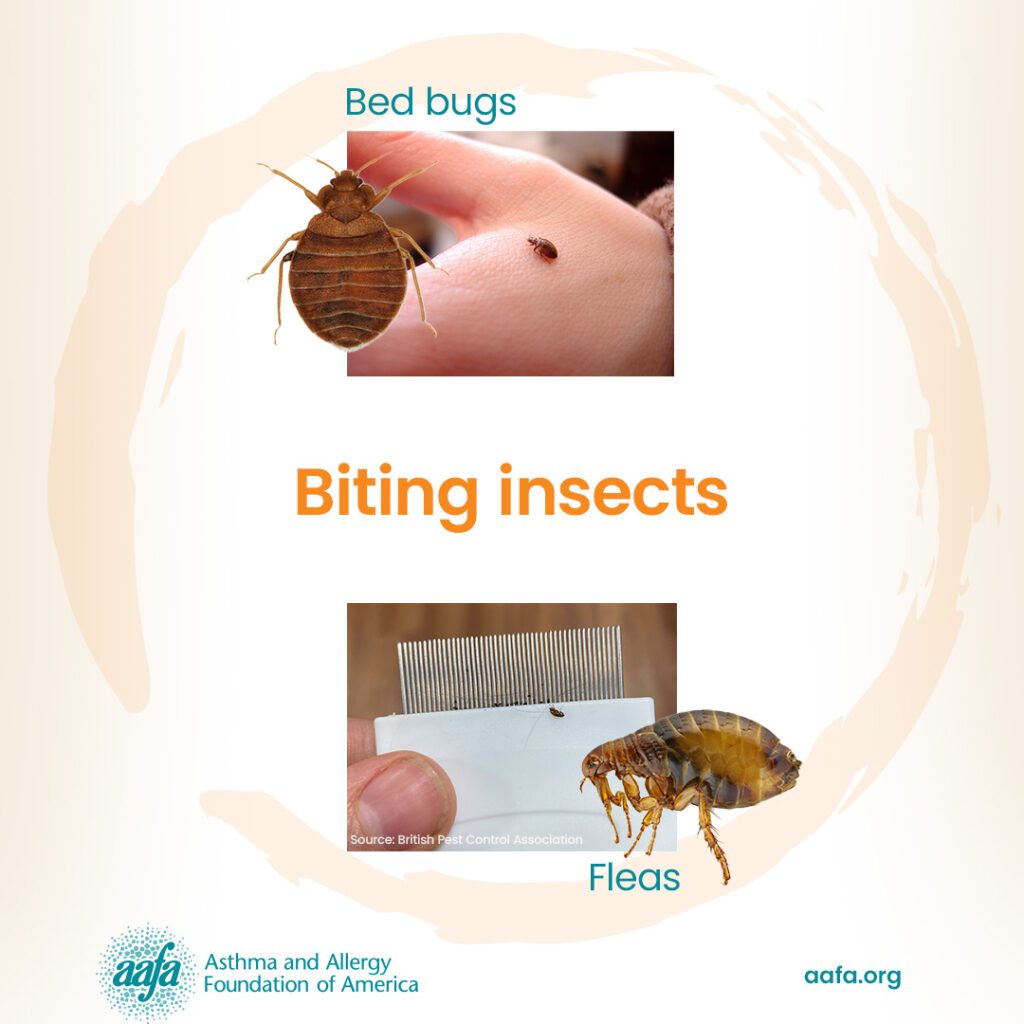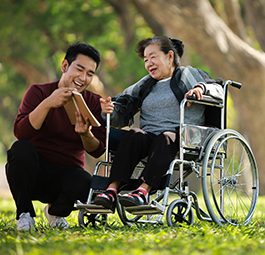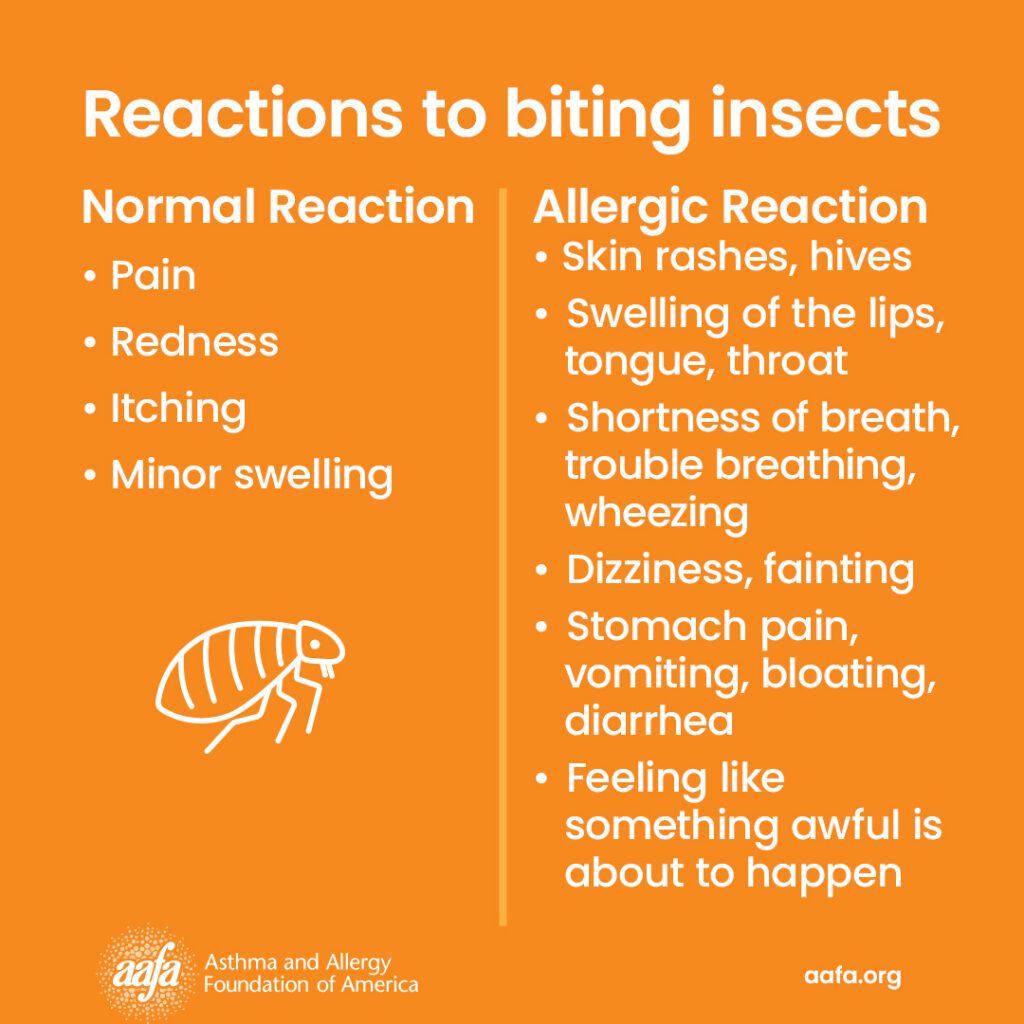Allergies
Biting Insect Allergy: Bed Bugs and Fleas
Bed bugs and fleas are common biting insects that live in many locations around the world. These insects bite humans to feed on their blood. Bed bugs are known to be active during the night and to bite humans while they sleep. Fleas prefer to bite pets but can bite humans too, especially when hungry.1,2
Bed bugs and fleas are known to cause allergic reactions. Most people bitten by insects suffer pain, redness, itching, and minor swelling in the area around the bite.3 Rarely, bed bugs and flea bites may trigger a life-threatening allergic reaction.1,2
What Is Bed Bug or Flea Allergy?
When a bed bug or a flea bites a person, its saliva transfers allergens into the person’s bloodstream. An allergen is a substance that causes an allergic immune reaction.1,2
Everyone is at risk of being bitten by bed bugs when visiting an infested house or room. Bed bug bites occur more frequently in people who live in under-resourced communities and areas with a high concentration of people, such as apartments. People who travel frequently and share living and sleeping space with other people are also at risk.1,3
Fleas prefer to bite animals. But, if there isn’t an animal nearby, fleas will bite anyone. Close contact with infested pets is a risk factor for flea bites. Visiting a building or space that was previously occupied by infested animals is also a risk factor, because fleas can hide in the floorboards and carpets. Body heat, breathing, movement, and vibrations attract fleas.2,4
What Are the Symptoms of Biting Insect Allergy?
Most people who are bitten by bed bugs or fleas may have pain, redness, itching, and minor swelling in the area around the bite. This is a normal reaction. Most people get better within hours or days.
Bed bugs and flea bites are similar and look like small red bumps or welts that may itch. However, flea bites usually appear on the lower half of your body, such as your feet and ankles. Bed bug bites appear on body parts exposed when you sleep such as the upper half of your body, around the face, neck, and arms.3,5
The “breakfast, lunch, and dinner” pattern is a commonly recognized sign associated with bed bugs or fleas. This pattern is characterized by small clusters of typically 3 or more bites, spaced just a few centimeters apart. This is thought to be a result of the bug feeding multiple times during 1 session. The bites can be arranged in a row, a triangle, or a zigzag line (more common for bed bugs).1,2,6 These clusters of bites may look very similar to hives. But, hives can disappear and reappear or change location or size over short periods of time, while bed bugs and flea bites remain at the site of the bite. If you notice that your marks seem to be moving, then you probably have hives.7
If you are allergic to bed bugs and fleas, these insects’ bites can cause localized reactions (limited to one area of the body) such as hives or rash. The affected area may also swell, and a blister may appear. Scratching the blister and the affected area may lead to infections.5
However, on rare occasions, people can have a serious allergic reaction to bed bugs and flea bites.1,2 A life-threatening allergic reaction (anaphylaxis [anna-fih-LACK-sis]) produces signs and symptoms that require immediate medical treatment with epinephrine. Symptoms usually involve more than 1 organ system (part of the body), such as the skin or mouth, the lungs, the heart, and the gut. Some symptoms include:
- Skin rashes, itching, or hives
- Swelling of the lips, tongue, or throat
- Shortness of breath, trouble breathing, or wheezing (whistling sound during breathing)
- Dizziness and/or fainting
- Stomach pain, vomiting, bloating, or diarrhea
- Feeling like something awful is about to happen
How Do Doctors Diagnose Biting Insect Allergy?
To diagnose a bed bug or flea allergy, your doctor may give you a physical exam and discuss your symptoms and your history of allergic reactions. The doctor may search your skin for the “breakfast, lunch, and dinner” pattern, as this pattern is typical for bed bugs and flea bites. The examination of debris from vacuuming and bedding may also be helpful to identify the insect and confirm the diagnosis.1,2
If your doctor thinks you have a biting insect allergy, they may suggest an allergy test.
Specific IgE blood test – Your doctor will take a blood sample and send it to a laboratory. The lab adds the allergen to your blood sample. Then they measure the amount of antibodies your blood produces to attack the allergens. This test is called specific IgE (sIgE) blood testing (this was previously and commonly referred to as RAST or ImmunoCAP testing). A positive blood test to an allergen does not necessarily mean that an allergen caused your symptoms.
What Is the Treatment for Biting Insect Allergy?
Most bed bugs and flea bites need only supportive care with over-the-counter medicine. Applying a corticosteroid [kor-tick-OH-stair-ROID] (usually hydrocortisone) cream to the bite site is usually enough to relieve the localized symptoms such as itching and swelling. An oral antihistamine can also be helpful to relieve itching.1,2 The localized pain and swelling may also be improved by applying a cold compress. Gently wash the bite site with soap and water to prevent infections. Do not scratch, since this could lead to infection.
Very rarely, reactions may become severe and cause systemic reactions such as anaphylaxis. If you experience symptoms like severe chest pain, nausea, sweating, shortness of breath, severe swelling, or slurred speech, you should immediately seek medical care.1,2
Epinephrine can reverse severe systemic reactions and is the most important treatment available for anaphylaxis. If you have a severe allergy to insect bites or stings, you should carry an easy-to-use form of epinephrine. You should also consider wearing a medical identification bracelet or necklace containing information about your allergy.
Immunotherapy [eh-mu-no-THER-ah-pee] (a therapy where you are given small doses of an allergen to help the body to build natural immunity to it) for fleas and bed bugs is not currently available. But, it is important to remember that scientific research is always advancing, and treatment options may change as new treatments are discovered.
How Can I Prevent Allergic Reactions to Bed Bugs and Fleas?
If you have a history of anaphylaxis to bed bugs or flea bites, then you should carry an easy-to-use form of epinephrine [ep-uh-NEF-rin], so you can quickly treat a reaction wherever you are.
Also, keep in mind that the best way to prevent allergic reactions to bed bugs and fleas is to prevent these insects’ bites.
To prevent bed bug bites, always check your hotel room, cabin, or other lodgings when traveling. Place your luggage in the bathroom or other tiled area while you check your hotel room, because there are fewer spots for bed bugs to hide in bathrooms. Carefully inspect the furniture for bed bugs, especially bedding, mattress, headboard, and any fabric-covered furniture. Look for specks of blood, rusty red or purple staining on the ticking of the mattress, live bed bugs, and bed bug feces, eggs, or shed skin. After inspecting the furniture, inspect the rest of your room. When you get home, always check your luggage and belongings before unpacking to make sure no bed bugs come home with you. Avoid bringing secondhand furniture into your home before checking it carefully. If you use shared laundry facilities, consider transporting items to be washed in plastic bags. Remove the clothes from dryer directly into bag and fold at home. Vacuum your house frequently. If you discover a bed bug infestation at your home, consider consulting or hiring a professional pest control company.6,8
To prevent flea bites, keep your pet free of fleas by avoiding contact with wild and stray animals, and limiting the time your pet spends outdoors. Check for fleas, and bathe and brush your pet regularly. Talk to your veterinarian about flea control products that are right for your pet. To keep fleas out of your home, sweep or vacuum well and often, including carpets, rugs, cushions on chairs, and sofas. Clean bedding frequently with soap and water, especially your pet bedding. Mowing frequently, avoiding over-watering, and raking thoroughly to remove any debris help to keep fleas out of your yard. Don’t leave food outside and keep your garbage can closed because it may attract wild animals that carry fleas. When outdoors, wear long-sleeved clothing and pants to reduce exposure to bites. Consider using shoes, clothes, and gear previously treated with permethrin (an insecticide). Always wear gloves if you are handling sick animals.9
How Can I Identify Bed Bugs and Fleas?

Bed bugs are tiny, wingless insects with a flat, red-brownish body. An adult bed bug can be the size of an apple seed when fed and full of blood. Young bed bugs and hungry bed bugs are about the size of a poppy seed. Bed bugs thrive in dark and warm places and often can be found in the crevices of mattresses, box springs, headboards, couches, and other places such as flooring, and walls. These insects are active at night and only come out to feed. Most of the time you can only find some signs of the bed bugs, such as a sweet, musty odor, specks of blood on bedding, rusty red or purple staining on the ticking of the mattress or bed bug eggs or shells. Bed bugs can be found anywhere in the world, even in 5-star hotels and resorts. The existence of bed bugs is not determined by how good the hygiene and housekeeping of a place are.3,6,10
Fleas are tiny, wingless insects with a dark, reddish-brown color. Their bodies are hard and flat on the sides. Fleas have long hind legs adapted for jumping, which makes them able to jump over 100 times their length. These insects can be found worldwide but are rare in low-humidity environments. Fleas are more active when the weather is warm and live in grass, trees and bushes, and can hop onto animals when they walk in the area. Fleas can be found on a wide variety of mammals and feed on their blood, including domestic pets, such as cats and dogs. Fleas usually suck out more blood than they need. This excess of blood dries and falls as small black pellets that can be identified after combing the fur of the pet.2,11
Closed
References
- Ennis, A. C., & Pearson-Shaver, A. L. (2023, July 31). Bedbug Bites. In StatPearls. StatPearls Publishing. Retrieved May 1, 2025, from: https://www.ncbi.nlm.nih.gov/books/NBK538128/
- Anderson, J., Saleh, H. M, Paterek, E. (2024, March 20). Flea Bites. In StatPearls. StatPearls Publishing. Retrieved May 1, 2025, from: https://www.ncbi.nlm.nih.gov/books/NBK541118/
- Centers for Disease Control and Prevention. (2024, April 26). Bed Bugs. Retrieved May 1, 2025, from: https://www.cdc.gov/bed-bugs/about/index.html
- Cleveland Clinic. (2021, August 31). Flea Bites. My Cleveland Clinic. Retrieved May 1, 2025, from: https://my.clevelandclinic.org/health/diseases/21718-flea-bites
- (2024, December 17). What’s the Difference Between Flea Bites and Bedbug Bites?. Healthline.com. Retrieved May 1, 2025, from: https://www.healthline.com/health/flea-bites-vs-bed-bug-bites
- American Academy of Dermatology. (n.d.). Bedbugs: Diagnosis and Treatment. Retrieved May 1, 2025, from: https://www.aad.org/public/diseases/a-z/bed-bugs-treatment
- American College of Allergy, Asthma and Immunology. (2018, June 11). Hives. Retrieved May 1, 2025, from: https://acaai.org/allergies/allergic-conditions/skin-allergy/hives/
- United States Environmental Protection Agency. (2025, March 6). Bed Bugs. Retrieved May 1, 2025, from: https://www.epa.gov/bedbugs
- Centers for Disease Control and Prevention. (2024, April 26). Preventing Fleas. Retrieved May 1, 2025, from: https://www.cdc.gov/fleas/prevention/index.html
- Voelker R. (2025). What Are Bedbugs? Journal of the American Medical Association, 333(8), 732. https://doi.org/10.1001/jama.2024.23447
- Shetlar, D. J., & Andon, J. E. (2012, January 5). Fleas [Fact sheet]. Ohio State University. Ohioline. https://ohioline.osu.edu/factsheet/HYG-2081-11
Med Communications, Inc. assisted with development and review of medical content. Medical review: May 2025 by Jeffrey G. Demain, MD.












